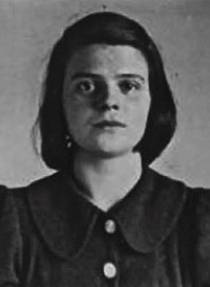
FAQ About Sophie Scholl

Who was Sophie Scholl?
Sophie Scholl was a German student and anti-Nazi political activist who became a symbol of resistance against Hitler's regime. She was a member of the White Rose, a nonviolent resistance group that opposed the Nazi dictatorship through the distribution of leaflets and other activities.

What was the White Rose?
The White Rose was a nonviolent resistance group in Nazi Germany, founded by students, including Sophie Scholl and her brother Hans Scholl, and a professor at the University of Munich. The group is best known for its anonymous leaflets that called for active opposition to the Nazi regime.

Why is Sophie Scholl considered a symbol of resistance?
Sophie Scholl is considered a symbol of resistance due to her courageous actions against the oppressive Nazi regime. Despite the significant dangers, she and her group members peacefully advocated for freedom and justice, ultimately sacrificing their lives for their cause. Her bravery has made her an enduring symbol of moral integrity and civil courage.

How did Sophie Scholl oppose the Nazi regime?
Sophie Scholl opposed the Nazi regime by distributing anti-Nazi leaflets and advocating for peaceful resistance. As a member of the White Rose, she helped write, print, and distribute leaflets that condemned the Nazi government and called for German citizens to rise up against it.

What happened to Sophie Scholl?
Sophie Scholl was arrested by the Gestapo on February 18, 1943, along with her brother Hans, for distributing leaflets at the University of Munich. After a show trial, they were convicted of treason and executed by guillotine on February 22, 1943.

What were the charges against Sophie Scholl?
Sophie Scholl was charged with treason, undermining the military, and aiding the enemy due to her involvement in the White Rose's anti-Nazi activities, including the distribution of leaflets that called for resistance against the Hitler regime.

What influence did Sophie Scholl's actions have on Germany?
Sophie Scholl's actions, along with the White Rose, inspired later resistance movements and have become emblematic of moral courage and resistance against tyranny. Her story has been retold in various forms, serving as both an inspiration and a reminder of the importance of standing up for one's beliefs in the face of oppression.

How is Sophie Scholl remembered today?
Today, Sophie Scholl is remembered as a heroine and symbol of resistance. She is honored in Germany and worldwide through documentaries, films, literature, and memorials. Her legacy is celebrated on university campuses and in various educational programs that emphasize the importance of civic responsibility and resistance against injustice.

Did Sophie Scholl act alone in her resistance activities?
No, Sophie Scholl did not act alone; she was a member of the White Rose, which included several university students and their professor. This group collaborated in writing, printing, and distributing leaflets that opposed the Nazi regime.

What were the main ideas promoted in the White Rose leaflets?
The White Rose leaflets primarily called for passive resistance against the Nazi regime. They emphasized the moral duty to oppose injustice and condemned the atrocities committed by the Nazis. The leaflets urged citizens to stand for freedom and human rights.

How did the Gestapo discover the White Rose activities?
The Gestapo discovered the White Rose activities after Sophie and Hans Scholl were spotted distributing leaflets at the University of Munich. They were reported by a university janitor, leading to their arrest and the subsequent investigation that led to the capture of other group members.

Was Sophie Scholl's execution well-publicized at the time?
Sophie Scholl's execution was not well-publicized by the Nazi regime at the time; they aimed to minimize attention to resistance efforts. However, news of her courage and the trial spread discreetly and became known to the Allies and German citizens opposed to the Nazi regime.

How has popular culture depicted Sophie Scholl?
Sophie Scholl has been depicted in various forms of popular culture, including films such as "Sophie Scholl: The Final Days," which dramatizes her arrest and trial. Her story has also been featured in books and documentaries, highlighting her courageous stand against tyranny.

What motivated Sophie Scholl to join the White Rose?
Sophie Scholl was motivated by her strong moral convictions and desire for justice and freedom. Witnessing the atrocities committed by the Nazi regime, she felt compelled to take action and advocate for what she believed was morally right, leading her to join the White Rose group.

What impact did the White Rose have after their members were executed?
After the execution of its core members, the White Rose had a profound impact by inspiring future resistance movements and highlighting the power of youth activism. Their bravery and the ideals expressed in their leaflets continued to influence post-war generations and inform discussions on civil courage.

Are there memorials dedicated to Sophie Scholl and the White Rose?
Yes, there are several memorials dedicated to Sophie Scholl and the White Rose. In Munich, there are memorial plaques at the University of Munich, where the group was active. Elsewhere, schools, streets, and buildings have been named after Sophie Scholl to honor her legacy.

Did Sophie Scholl have any prior anti-Nazi activities before joining the White Rose?
Before joining the White Rose, Sophie Scholl was involved in youth groups that were subtly critical of the Nazi regime. Her early exposure to diverse perspectives through her family and education played a role in shaping her critical stance against Hitler's oppressive governance.

What is the legacy of the White Rose movement today?
The legacy of the White Rose movement today is embodied in the ongoing fight for human rights and justice. The group's emphasis on nonviolent resistance and moral courage serves as an inspiration for individuals and movements resisting oppressive regimes globally.

How does Sophie Scholl's story inspire modern resistance movements?
Sophie Scholl's story inspires modern resistance movements by exemplifying the impact of peaceful protest and the importance of standing up against injustice. Her actions demonstrate how courage and integrity can influence change, encouraging activists to advocate for human rights and democracy.

What was Sophie Scholl's educational background?
Sophie Scholl was a student at the University of Munich, where she studied biology and philosophy. Her education and exposure to various intellectual circles contributed to her critical thinking skills and her active involvement in the White Rose resistance group.
